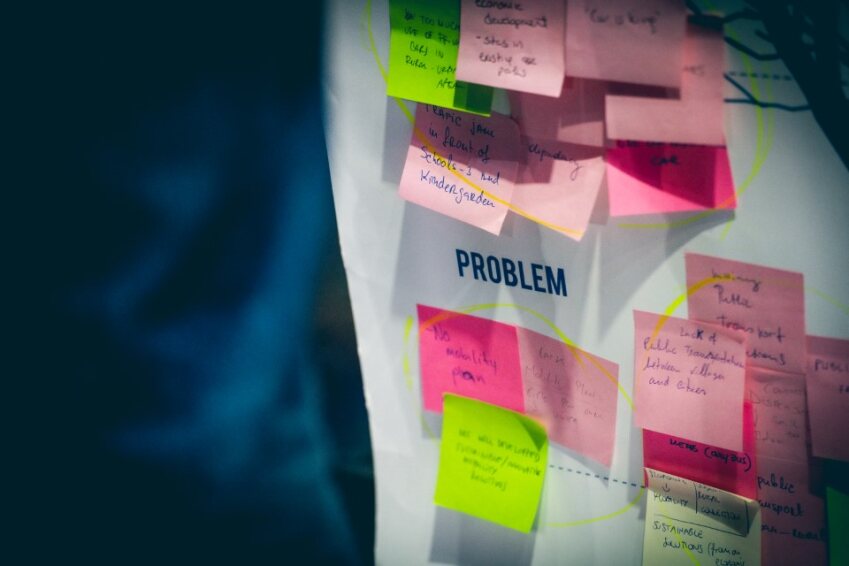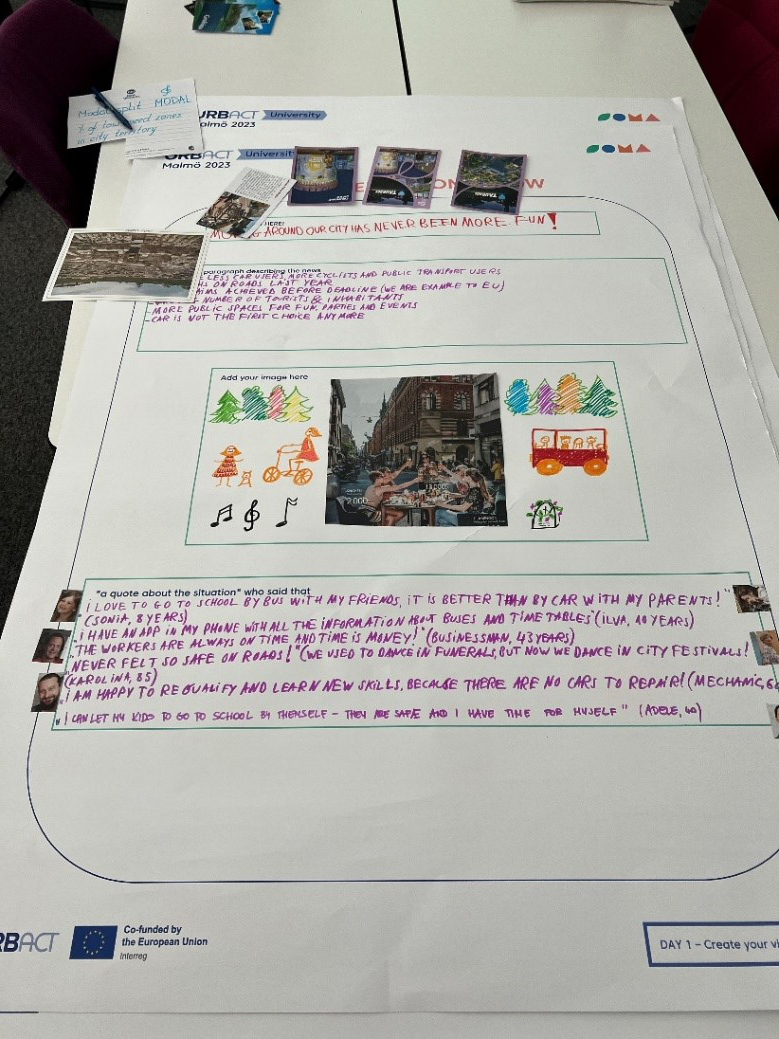The complex interplay between "here and now" and "there and then"
Drawing on the findings of the URBACT study on Integrated Action Plans conducted in 2022, it has become evident that effective plans are characterised by “a clear yet concise presentation of needs and context”. This presentation feeds into strategic decision-making, where the groundwork of understanding the context, the problem with its causes and consequences, seamlessly aligns with the envisioned future. However, it's worth noting that the connection between problem definition and vision is far from straightforward or predictable in the dynamic landscape of urban life.

In reality, problems and visions are interwoven, intersecting within the complex web of vertical and horizontal governance dynamics, intricate problems, and transitions. Furthermore, not all visions are locally generated, in some cases they are created for the local people but not by them. Cities and communities are simply expected to adapt to them. For instance, consider the topic of urban mobility.
Smaller and medium-sized cities, such as in the case of the PUMA - Plans for Urban Mobility Actions network, may lack robust public transportation systems. Local people end up relying heavily on cars, with limited resources for infrastructure. Despite this, cities are required to harmonise with the overarching vision of the European Sustainable Urban Mobility Planning (SUMP) concept and the EU Green Deal. To compensate, wider urban areas must skilfully balance their local issues, scrutinised under a magnifying glass, with their gaze fixed on the horizon through binocular-like bifocal lenses. This approach serves as a potent catalyst for the entire action-planning process.
Leveraging on the URBACT tools
As a part of the URBACT Toolbox two particular tools, the Problem Tree and Newspaper of Tomorrow, were tested by both URBACT newcomers and seasoned veterans from the recently approved Action Planning Networks. In the framework of the URBACT University 2023 in Malmö (SE), from 28 to 30 August, 400+ participants from all over Europe had the opportunity to try out such tools on the first day of the event.
 First, the Problem Tree, also known as the "Cause-and-Effect Tree" or "Issue Tree," consists of a visual representation that can be used to dissect and comprehend complex problems systematically. It achieves this by deconstructing intricate problems into their constituent elements. It consists of two primary components: the "roots", the causes; and the "branches", the effects or consequences. At last, the problem manifests itself in the tree trunk. This tool effectively breaks down problem complexity into manageable sub-issues, offering insights into the root causes and consequences of a specific issue, ultimately advancing in the definition of strategic objectives.
First, the Problem Tree, also known as the "Cause-and-Effect Tree" or "Issue Tree," consists of a visual representation that can be used to dissect and comprehend complex problems systematically. It achieves this by deconstructing intricate problems into their constituent elements. It consists of two primary components: the "roots", the causes; and the "branches", the effects or consequences. At last, the problem manifests itself in the tree trunk. This tool effectively breaks down problem complexity into manageable sub-issues, offering insights into the root causes and consequences of a specific issue, ultimately advancing in the definition of strategic objectives.
“The tools activate a diverse range of skills and mindsets necessary for participatory planning processes” reminds Claus Kӧllinger, Lead Expert of the SCHOOLHOODS network, tackling green urban mobility transition by placing schools at the heart of the 15-minute city. These skills encompass analytical expertise, including critical thinking, communication, and empathy. Along with strategic and systems thinking, imagination, creativity, both tools reinforce collaborative work and conflict management.
In the context of interregional cooperation, the Problem Tree can be also adapted to different realities as proposed by the URBACT S.M.ALL - Sharing Urban Solutions towards Sustainable Mobility for All network. This network comprises a diverse array of cities, ranging from large metropolises, to medium and small-sized cities and even an aggregation of municipalities.
“It's essential to acknowledge that city dimensions and positions within larger functional areas significantly alter the scale, focus, and complexity of urban mobility challenges” explains Pietro Elisei, the Lead Expert of S.M.ALL. "So, we have decided to create two different Problem Trees", he continues. This choice reflects the need to cater to the distinct mobility issues faced by larger and smaller cities.
 While the overarching challenge may revolve around car-centricity, city size influences the specific problems and demands related to urban and peri-urban mobility. Large cities often grapple with disparities in transportation access, with certain neighbourhoods enjoying higher access to and affordability of public transit and mobility options.
While the overarching challenge may revolve around car-centricity, city size influences the specific problems and demands related to urban and peri-urban mobility. Large cities often grapple with disparities in transportation access, with certain neighbourhoods enjoying higher access to and affordability of public transit and mobility options.
Conversely, smaller cities contend with the scarcity of public transportation and limited budgets for infrastructure and maintenance, posing challenges in addressing issues like road quality or creation of safe cycling lanes and the expansion of public transit solutions, particularly for in-city and intercity mobility. Although the two Problem Trees within the S.M.ALL network share commonalities concerning root causes and their subsequent impacts and consequences, the contextual backdrop and primary issues show unmistakable differences.
The visual metaphor of the tree, therefore, appears as an excellent tool for engaging stakeholders, fostering communication and collaboration among city officials, community members, and other relevant stakeholders. Its structured layout assists in understanding the intricate relationship between various facets of an issue, thereby enabling the development of more effective and comprehensive strategies tailored to local contexts.
Seeing the invisible?
The Newspaper of Tomorrow stands as a forward-thinking envisioning technique that harnesses creativity and forward-looking perspectives. This tool finds application across various realms of urban planning and beyond, sparking innovation, empathy, and scenario crafting skills. The primary objective of this tool is to create a vivid and compelling narrative, envisioning the successful realisation of a particular project, initiative or vision as if it has already materialised. “This approach encourages individuals or local multi-stakeholder groups to immerse themselves in a future scenario where their envisioned change has come to fruition” maintains Karolina Orcholska, Lead Expert of PUMA, when referencing to the URBACT Local Groups.

A headline from the PUMA’s 2030 newspaper, focusing on medium and small-sized cities striving to create Sustainable Urban Mobility Plans to reduce carbon emissions, reads, "Moving around our city has never been more fun!". In essence, this single word "fun" encapsulates the restoration of collective well-being.
The Newspaper of Tomorrow encourages people to think about possible quotes of citizens too. Consider Sonia, who now enjoys her school commute by bus with friends, or Adele, Sonia's mother, who relishes the additional time she has for herself. Reflecting on the transformation, 85-year-old Karolina remarks, "We used to dance at funerals, now we dance at the city festival in the streets!". The headlines and quotes vividly illustrate how the reduction of cars, the creation of sustainable transportation alternatives, reduced pollution and shifts in mobility behaviours have had a positive impact on the mental and physical health and safety of various segments of the population.
The strength of the Newspaper of Tomorrow lies in its brevity of execution compared to other envisioning and scenario planning techniques, such as workshops, scenario building and forecasting methods. It captures all the essential elements — impact on people, synthesising capacity, empathic capability, and visualisation of change — necessary for the initial phases of action-planning. “This tool can stimulate the URBACT Local Group to collectively compose a shared vision of the desired transformation” recommends Karolina Orcholska.
Moving from the present to the future and back
The ability to shift the focus from the challenges of the "here and now" to envisaging a transformed future serves as a stimulus within the URBACT's integrated and participatory approach. It not only triggers introspection regarding the adequacy of problem definition, but also initiates a process of backcasting. Increasingly integrated into sustainable urban development, backcasting techniques begin with a future vision and work backwards, systematically delineating the conditions, steps, innovations, practices, and policy design and planning details essential for realising a city's long-term goals and ambitions. Such exercise came to fruition with the URBACT tools used for the last day of the event, particularly the Integrated Action Plan Canvas.

Factoring in the human dimension
Problem Trees and Newspapers of Tomorrow may trigger the action-planning process, representing wide-ranging challenges and approaches to sustainable urban development in a time marked by epochal transitions. In other words, they mark the tentative initial and final steps of the whole journey, which require continuous review and adjustments of the overall vision and objectives over time.
When devising integrated and sustainable solutions and strategies, the human factor takes centre stage, encompassing diversity, skills, culture, and perspectives. From the initial stages on, stakeholders and collaborative efforts are the cornerstones of success.
How Networks and cities manage to engage, bring onboard and leverage their stakeholders’ strengths significantly influences the outcomes. And this is the focus and purpose of the tools and activities of the second day of the University.


